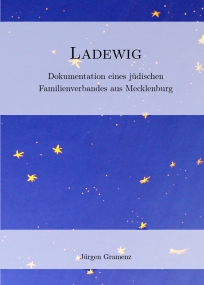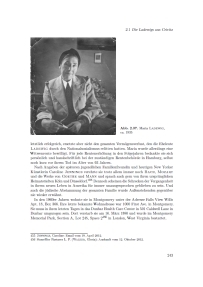Ladewig: Documentation of a Jewish Family Clan from Mecklenburg
Ladewig: Dokumentation eines jüdischen Familienverbandes aus Mecklenburg
(Ladewig: Documentation of a Jewish Family Clan from Mecklenburg)
Jürgen Gramenz
Plaidt 2013
Cardamina® Verlag Susanne Breuel
ISBN 978-3-86424-086-7
400 pages
81 pictures
DIN B5, hard cover
Purchase options:
Cardamina® Verlag
Amazon.de
Lehmanns Media


„If you do what is right, will you not be accepted? But if you do not do what is right, sin is crouching at your door;
it desires to have you, but you must rule over it!“
(Bereishit / Genesis 4:7) Dedicated to all descendants and relatives of the Jewish Ladewig family.
In remembrance of the Jewish communities of Crivitz and Brüel.
And in loving memory of all, who were murdered by the SS-Kavallerie-Brigade under command of the Kommandostab Reichsführer-SS in Chomsk, Motol, Telechany, Swieta Wola, Wygonoska, Chotonice, Hancewicze, Kamien- Koszyrski, Lubiaz, Odrozyn, Janow, Borobice, Lohiszyn, Pinsk, Polesje, Dawidgorodek, Koziangrodek, Lunin, Luninez, Pohost Zagorodny, Stolin, Starobin, Mosyr, Toropez, Petrikow, Lenin, Retschiza, Choiniki, Bragin, Bobruisk and uncounted other villages.
Content
The trigger for this historically-biographical book was a random DNA test that revealed an unexpected family secret, which tragically combined the victims and the perpetrators of the Nazi era in one family. A two-year search for answers led to a collection of materials that allowed an almost complete description of a Jewish family from Mecklenburg. Based on reconstructed biographies of over fifty of various branches of the family and its members the rise and fall of the family Ladewig is shown in its entirety and with extensive references to the general history of the Jews in Mecklenburg over a period of 200 years.
Fleeing from Cossack raids and pogroms in Western Galicia in the beginning of the 18th century the first ancestors of the Ladewigs found a new permanent home in the cities of Mecklenburg Crivitz and Brüel. In addition to the everyday problems and disputes within the Jewish communities, with the authorities or during their integration in the German community, friendships and successes in these Mecklenburg country towns are illustrated. Numerous, previously unreleased and first sighted sources from state and city archives were analyzed, which not only affect the Ladewig family, but also the history of the Jews in Mecklenburg in general. Thus, the process of the adoption of family names of the Jews in Mecklenburg during their emancipation movement in the years 1813/14 in the historical circumstances is shown.
In the middle of the 19th century a counter emancipation of the German population took place (so called Hep Hep riots „Hep-Hep-Krawalle“) and provided the basis for one of the few attacks in Mecklenburg, which affected the family member Levin Ladewig. In 1819, he became a victim of a minor incident in Schwerin. But the case was exaggerated later by the Duke and led to a remarkable judicial farce of a special kind. The entire process has been transcribed from the original documents and is now published in the book for the first time.
Were the first Ladewigs yet simple coat and junk dealers who could feed their families only sparsely, they became preferred „Productenhändler“ after receiving trade privileges from the Duke and finally reached respected merchants with thriving shops and considerable prosperity. Thus, their children had a better start in life and now could study at universities in Germany or even abroad. Among these offsprings was the known Chemnitz manufacturer, millionaire and head of the Jewish community Kommerzienrat Louis Ladewig. The late 19th century industrialist stood for a rare type of responsible and social entrepreneur. His steep social climb did not prevent him to take care of its employees and to let them share in the economic success. Even his two hometowns Malchow and Chemnitz became a lot of benefit from him by various endowments and social foundations. In cooperation with the will manager of his son Karl Ladewigs, who survived survived the German occupation in the Belgian underground and later was only called Charles Ladewig, the bequest was sighted and so the lives of this family and the rise and decline of the company Bachmann & Ladewig AG was reconstructed.
Besides many merchants the family later also included medical doctors and lawyers. The political career of the Justizrat Carl Laser Ladewig, who like other relatives also worked as a lawyer in Berlin, finally led him as an elected alderman to the city parliament of Berlin. In this way he handled the political fortune of Berlin for 25 years. Some of his eloquent speeches, which illustrate the former parliamentary wit, are also published here.
As with all Jewish families, the darkest chapter of German history influenced this family in a disastrous way too. The reader is able to retrace the impact of the Holocaust by different individual and family stories - from the early hostility over the looting and persecution and eventually to the final destruction of entire family branches. Especially the fate of the salesman Walter Ladewig, who was convicted of miscegenation and then couldn’t escape the Nazi justice later, is described in detail.
Documented is also the looting and the escape of the Berlin lawyer Fritz Ladewig and his wife Maria, which literally went around half of the globe. But even in their exile countries the escaped emigrants were not safe. For instance, many German and Austrian Jews who had fled from the persecution to England, were interned and deported as enemy aliens by the British Government. In 1940, one of their sons Paul Erwin Ladewig (Paul Edward Lawrie), was interned as such an enemy alien and despite the permanent U-boat threat deported to Australia with the H.M.T. „Dunera“. This was exactly the infamous incident which would later become the term „Dunera affair“ for which Winston Churchill later apologized with the „Dunera Boys“.
Often only through fortunate circumstances never published life stories and testaments have been discovered which alowed to that a look at the historical facts from the perspective of the individuals of these times. In particular, the love letters of a family member from 1941 to 1945 were a priceless discovery. Hans Jochen Ladewig (John Frederick Lawrie), who managed to escape to England in 1939 as a teenager, was also interned like his brother Paul, but then was deported to Canada with the S.S. „Ettrick“. After his return and the entry into the British Army as a trooper and tank operator of the 8th King’s Royal Irish Hussars, he survived the famous battle at Villers-Bocage and the bloody battle of the Operaton Veritable. His last letter he wrote from the Western Front in February 1945. It was almost exactly a month before he was killed by a German Panzerfaust only a few kilometers back on German soil in a raid with his Challenger tank to an insignificant village. So he shared the fate of so many members of the still often unknown „Churchill’s German Army“ which made a heavy toll on the liberation of Western Europe.
A no less intimate time document that has been tracked for this book, is the video testament of the Holocaust survivor Ruth Ladewig Sonnenschein. At the age of 89 years she reports not only about the threatening situation in Nazi Germany, the circumstances of her escape to Czechoslovakia and later to America and the related historical background, but also about her trivial desires and first flirtations of a young woman during this difficult time.
The analyzed materials allow not only an insight into the pure historical facts, but also a participation at the now so distant thoughts and feelings of victims and refugees. And like the biographies of Hans Carl and Adelheid Ladewig show the escapees sometimes had a difficult new beginning in the exile countries.
And also from a genealogical point of view the book should be more than satisfying. It contains numerous links to other Jewish families and known historical actors, such as the Nazi judge Roland Freisler or the artist Henry van de Velde. The index of people provides 1,500 name entries, many of which were Jews from Mecklenburg. Almost complete family pedigrees with over seven generations, which were created on the basis of of the rescued and during the investigation extended family tree, complete the picture of the family clan.
Although this is a contemporary historical documentation, the book must be seen as it was originally conceived: a late redress and an obituary for a Jewish family whose name is extinguished forever.